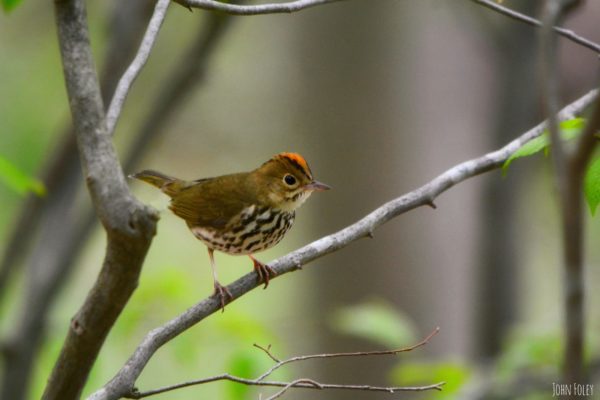What Birds And Animals Eat Japanease Barberry

New Research Published on the Effects of Invasive Japanese Barberry on Birds
Exotic, invasive plants often spell trouble for birds whose habitats are under siege. They can modify food affluence, nest site availability, and other critical resources. However, our new report published this calendar week in the journal Conservation Physiology shows that the relationships between exotic, invasive plants and native birds are not always that simple and non e'er negative. Researchers from Smashing Hollow and our collaborator from the Rochester Institute of Engineering science institute that Japanese barberry – one of the virtually widespread and vilified exotic shrubs in the northeastern U.S. – does not reduce habitat quality for a woods-breeding migratory songbird, the ovenbird, in a way that affects either its casualty affluence or physiological condition. "While our findings may be somewhat of a surprise to some, we recall they highlight the importance of investigating and understanding species-specific furnishings of non-native plants on wild animals rather than basing direction decisions on wide generalizations and assumptions, which can have unintended consequences," said Chad Seewagen, Corking Hollow'due south executive director and one of the study'south authors.
Japanese barberry was first brought to the U.S. through Boston in 1875 and by the 1960s had already spread throughout nearly of the Northeast. Still, more than one-half a century later, nosotros still know near nothing near the effects of Japanese barberry on woods wildlife. For the by iii years, Nifty Hollow has been working to change that through a series of studies beyond multiple wildlife taxa. The first phase of our research, published last twelvemonth, showed that the affluence and species richness of leaf-litter and branch-habitation arthropods are significantly diminished in barberry-invaded areas of the woods, with spiders, ants, and other predatory groups hit the hardest. Even so, it as well showed that the overall biomass of arthropods is not affected by Japanese barberry because of the taxa associated with information technology tending to be larger-bodied than those associated with native vegetation in the uninvaded areas of the forest. This could mean that food availability for basis- and understory-foraging insectivores, like many wood songbirds, is not affected by the changes in arthropod community composition caused past Japanese barberry, provided they are not specialized to feed on whatever particular taxonomic groups.
To begin answering this question of how insectivores higher in the food web are faring in barberry-infested habitat, we measured five status indices in breeding male ovenbirds that collectively provide information nigh a bird's energetic condition, aerobic scope, diet quality, infection status, and chronic stress level, all from a small sample of blood. We also collected and weighed foliage-litter arthropods again to measure out the affluence of food within each bird's territory. Like before, nosotros found no difference in arthropod biomass between forest patches that were heavily invaded by or relatively free of Japanese barberry. With no deviation in food affluence, it is mayhap unsurprising that Japanese barberry density had no effect on whatsoever of the markers of the birds' physiological status. In that location was also no tendency in ovenbird age or torso size that would indicate that the areas of the forest where barberry is sparse or absent-minded are in greater demand and therefore acquired by the largest, most dominant and experienced individuals in the population. Altogether, at that place was zippo amid the multiple factors examined in the study to indicate that Japanese barberry creates poorer habitat weather for breeding male person ovenbirds.
The researchers point to white-tailed deer as playing an important role in the furnishings of Japanese barberry on the ecology and wildlife of the forests it invades. "One possibility is that Japanese barberry provides some beneficial services as a surrogate for heavily browsed native plants in places where deer are overabundant, like in our written report site in New York," said Dr. Seewagen. Because Japanese barberry is unpalatable to deer, information technology oftentimes provides a shrub layer and structural heterogeneity in forests where these important features would otherwise exist largely defective due to the browsing pressure on native shrubs and regenerating trees. Farther, dense and thorny shrubs similar Japanese barberry can act as a bulwark to deer and thereby protect circumstantial native plants from browsing. Despite having lower arthropod species richness, it is possible that the greater overall density of shrubs in barberry-invaded areas of the forest allows those areas to back up a comparable level of casualty biomass for insectivores as do uninvaded areas of the forest that have a thin and open up understory caused past over-browsing. It may also provide meliorate nesting atmospheric condition for birds that nest in the understory or on the ground, like ovenbirds.
The authors circumspection that their study was express to one site and only ane of the many bird species that inhabit barberry-invaded forests of eastern North America. They besides annotation that in that location are many other aspects of breeding habitat quality that the written report did not examine, such as nesting success, although previous studies accept suggested that the nesting success of other songbird species is unaffected past Japanese barberry. "Our study merely scratches the surface, so we encourage hereafter research on additional bird species and factors such every bit pairing success, nestling quality, nest success, and post-fledging survival to develop a deeper agreement of how this widespread invasive plant is affecting habitat quality for birds," said Dr. Susan Smith Pagano, Bully Hollow's collaborator from RIT and another one of the report's authors. "This would allow for more science-based controlling by land managers who are confronted with barberry invasions. Removing barberry on a big calibration is challenging, so the effects of this plant on birds and other wildlife should exist better understood before allocating limited resources to its control."
For further reading, the commodity can exist accessed on the Conservation Physiology website hither.
Source: https://greathollow.org/news/new-research-published-on-invasive-japanese-barberry-and-birds/
Posted by: winklerwhadminvabot.blogspot.com

0 Response to "What Birds And Animals Eat Japanease Barberry"
Post a Comment